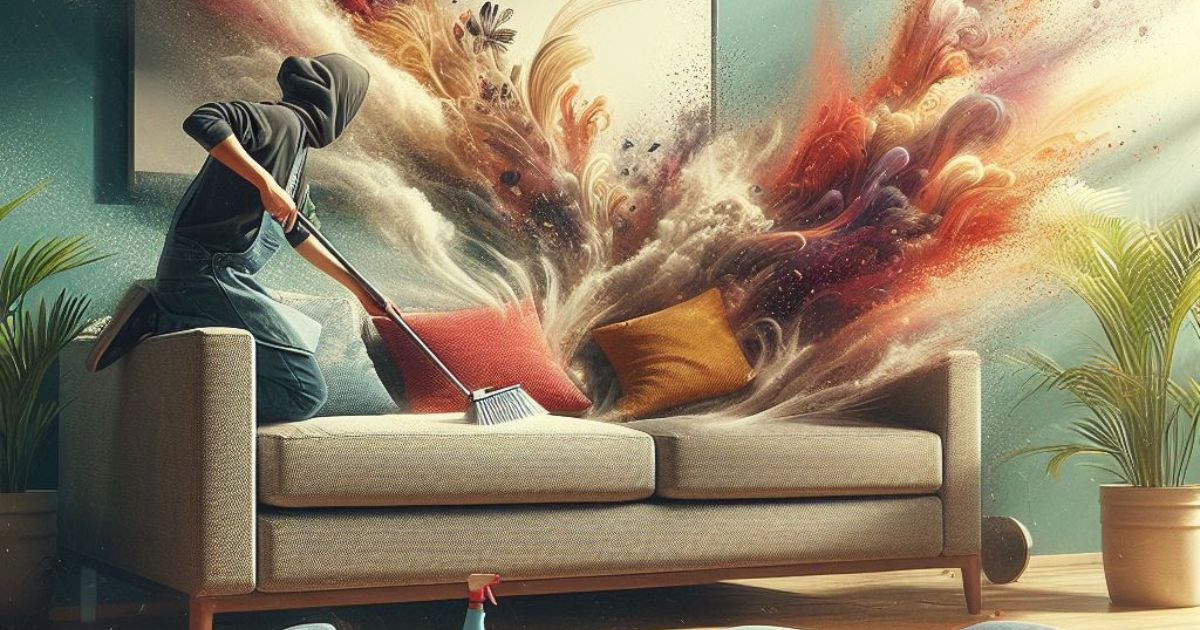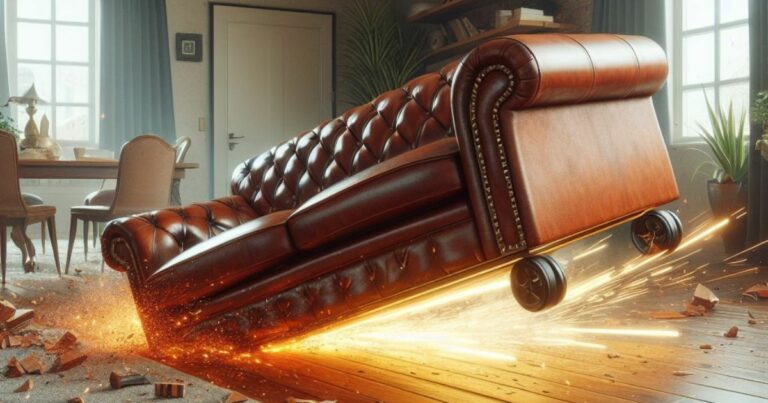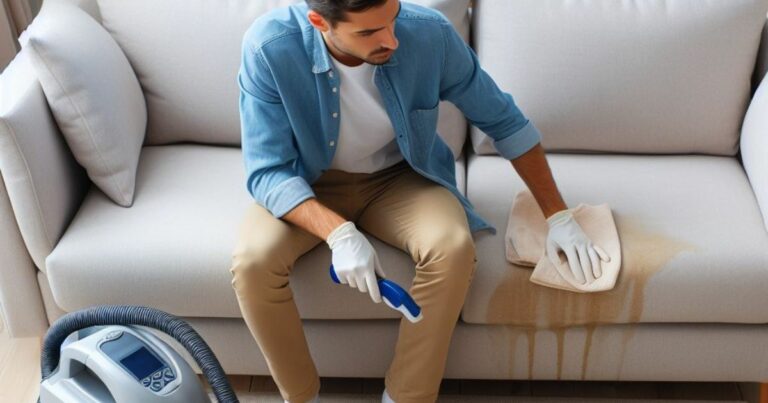Cleaning couch cushions might not be the most exciting part of your day, but it’s definitely an essential part of keeping my living space fresh and welcoming. Whether it’s getting rid of the crumbs from my latest snack session or tackling a stubborn wine stain, I’ve found that a regular cleaning routine can greatly extend the life and look of my couch. Couch cushions can collect a surprising amount of dirt and debris, and even the smallest spot can become an eyesore if left unattended.

Over time I learned that the best approach depends on the type of cushions I have. For those with removable covers, throwing them in the wash might do the trick, while others may need a bit of elbow grease and a homemade solution. I found making my own cleaner with everyday household items like vinegar, dish soap, and water to be quite effective for general stains. For specific fabric types, such as suede, a tailored approach using a water and alcohol solution can be necessary to avoid damage.
It’s always a smart move to check the care label first, as not all materials are created equal. If in doubt, I test a small, inconspicuous area with my chosen cleaning method. Regular maintenance, including vacuuming and the occasional deep-clean, can make a world of difference, keeping my couch cushions in top-notch shape for years to come.
Understanding Your Couch Cushion

Before diving into the cleaning process, it’s essential to know what kind of cushions you’re dealing with. I’ll guide you through identifying the cushion material and the manufacturer’s instructions for care.
Identify Cushion Material and Care Label
First off, check the care label found on your couch cushions. This tag typically provides crucial information about the fabric type and cleaning code. The cleaning code, which comes in a letter or a combination of letters (W, S, WS, X), tells you what cleaning methods are safe. W stands for water-based cleaner, S for solvent-based, WS for either, and X for vacuum or brush only.
It’s also worth noting whether you have removable cushions or non-removable cushions. Removable ones can often be much easier to clean since you can take the covers off and handle them separately. Non-removable cushions require a bit more care and spot-cleaning techniques.
Types of Couch Cushions
Couch cushions come in a variety of materials, each with specific cleaning needs. Here’s a quick rundown:
- Fabric cushions: These can be made of materials like cotton, linen, or synthetic fibers. Cleaning varies widely with fabric type, so stick rigidly to the care instructions.
- Leather cushions: Gentle cleansers designed for leather and conditioners will keep them in tiptop condition.
- Vinyl covers: These can often be wiped clean with a suitable solution, though be careful to avoid damage from over-wetting or harsh chemicals.
My tip for ensuring a thorough clean is to do a bit of research based on the cushion material and to follow those care labels closely. They’re there to help keep your cushions looking fresh for as long as possible!
Daily Maintenance and Spot Cleaning

To keep my couch looking fresh every day and tackle any mishaps effectively, I follow a couple of simple yet specific routines for vacuuming and spot cleaning.
Vacuuming to Remove Dust and Pet Hair
I make it a part of my weekly cleaning to run a vacuum cleaner across the couch, using an upholstery brush attachment to lift away dust and pet hair without damaging the fabric. For velvety textures, I use smooth, straight strokes, while I move in a circular motion for woven materials to ensure every nook is reached.
- Turn on the vacuum to its lowest setting.
- Gently pass the upholstery brush over all cushion surfaces.
- Pay extra attention to crevices where dust and pet dander tend to accumulate.
Spot Cleaning Techniques
Spot cleaning is my go-to method for addressing spills before they become stubborn stains. When I notice a spill, I immediately grab a clean sponge or cloth and blot the area, being careful not to rub it in. For food spills or marks, I use a solution of water and mild cleaning solution—a mix I always spot test on an inconspicuous area first.
- Blot spills gently with a dry cloth; avoid rubbing to prevent the spill from spreading.
- Apply a mild cleaning solution to a sponge and dab the affected area.
- Rinse the sponge with water, wring it out, and use it to remove any residue.
Dealing with Spills and Stains
I handle fresh spills immediately by soaking up as much liquid as possible with paper towels. For difficult stains, I’ve found a sprinkle of baking soda to be effective for absorbing and lifting the stain. If the fabric allows, a dabbing motion with a cloth soaked in rubbing alcohol can be a life-saver.
- For fresh spills:
- Blot immediately with paper towels.
- Use a lint roller to pick up any remnants.
- For set stains:
- Sprinkle baking soda on the stain and let it sit before vacuuming it off.
- Treat with a recommended stain remover as per the product’s instructions.
Washing Couch Cushions
Before I get into the nitty-gritty, remember that the most important step in washing couch cushions is to always check the care tag for specific cleaning instructions. Some cushions are machine washable, while others require hand washing or professional care.
Machine Washable Cushions
If my cushion covers are machine washable, I start by removing them and checking for any specific washing instructions. Here’s my straightforward process:
- Prepare: I ensure that any stains are pre-treated with laundry detergent.
- Machine Settings: I place the covers in the washing machine, set it to a gentle or delicate cycle, and use cold water to prevent shrinkage or fading.
- Detergent: A small amount of liquid detergent will do—too much soap can be hard to rinse out.
- Dry: After washing, I prefer to air dry the cushion covers because tossing them in the dryer can cause them to shrink.
Hand Washing and Deep Cleaning
When machine washing isn’t an option, hand washing or deep cleaning is the way to go. Here’s what I usually do:
- Bathtub Prep: I fill my bathtub with cold water and add 1-2 tablespoons of liquid detergent.
- Submerge and Agitate: I submerge my cushions in the soapy water and gently agitate them with my hands.
- Soak: The cushion should soak for about 15-20 minutes, but I make sure it doesn’t sit for too long as it can absorb too much water.
- Rinse: Rinsing is key; I rinse the cushion thoroughly with cold water to get all the soap out.
- Dry: To dry them, I wrap the cushions in towels to remove excess water and then let them air dry.
Using these methods, I make sure my couch cushions stay fresh and clean, contributing to a cozy and inviting living space.
Professional and Alternative Cleaning Methods
In this section, I’ll share tips on hiring professional cleaners and whipping up DIY alternatives for those special couch cushion fabrics.
Hiring Professional Cleaners
When it comes to giving your couch a thorough clean, professional cleaning services can be a lifesaver. They come equipped with heavy-duty steam cleaners that can handle all types of upholstery, including the delicate ones like velvet and silk. For leather couch cushions, pros use specific leather cleaners that safely remove dirt without damaging the surface. Plus, they have upholstery attachments designed to suck up the deep-seated grime from fabric couches.
- Tools Professionals Use:
- Steam cleaner with upholstery brush attachment
- Specialized leather, microfiber, and suede cleaners
- High-quality microfiber cloths
- Enzyme cleaners for organic stains
DIY Alternatives and Natural Solutions
Now, if you’re looking to clean your couch cushions on your own, there are quite a few DIY alternatives that work wonders. I swear by a solution of equal parts white vinegar and water for a natural and effective clean, especially on fabric couches. Microfiber couches can be tricky, but a tiny bit of rubbing alcohol on a microfiber cloth does the trick — just remember to dab gently. For suede cushions, forget about soaking them; instead, gently brush them after treating any spots with a bit of vinegar or a pencil eraser.
- DIY Mixes I Use:
- All-purpose cleaner: Equal parts white vinegar and water
- Microfiber spot cleaner: Rubbing alcohol with a microfiber cloth
- Enzyme cleaner for pet messes and food spills
Remember, not all DIY methods are suitable for every material, so always patch-test in an inconspicuous area first.








